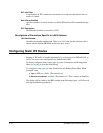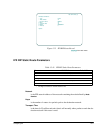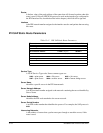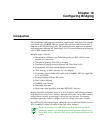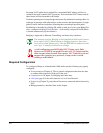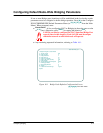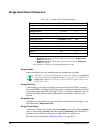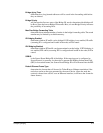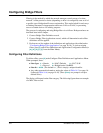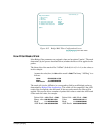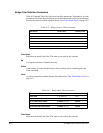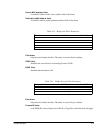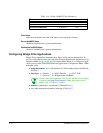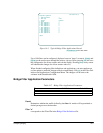
16-4 SmartSwitch 1800 4.0 User Guide, Rev 01
Bridge Node Default Parameters
1
To assure correct operation of the spanning tree algorithm, follow these rules:
a.
Bridge Max Age
must be less than or equal to twice the value of {
Bridge Forward
De lay
minus 1 second}.
b.
Bridge Max Age
must be greater than or equal to twice the value of {
Bridge Hello
Time
plus 1 second}.
2
This parameter is irrelevant on a a Token Ring SmartSwitch 1800.
Bridge Enabled
enables bridging in the node, implementing the spanning tree algorithm.
If Bridging is disabled, all Bridge ports on the node will go into
Forwarding
state (described under "Bridge Port Status" on page 20-22). No BPDUs (see
Bridge Hello Time
below) will flow. No data will be bridged except termi-
nated LLC2 traffic.
Bridge Hello Time
is the frequency with which all bridges on the network will send "Hello" messages
(also called BPDUs, or Bridge Protocol Data Units) to adjacent bridges (the next ones
in all bridge paths) when the local bridge is "Root." Note that a root bridge is the one
with the lowest ID (which contains its Bridge Priority and MAC address) on the
network.
Bridge Max Age
determines how long Hello messages will remain valid when the local bridge is root
(described under "
Bridge Hello Time
") .
Bridge Forward Delay
is the time the bridge will wait after entering
Listening
state before entering
Learning
state, or after entering
Learning
state before entering
Forwar ding
state This delay is
intended to assure that the tree topology is stable before it is put into use.
The states are described under "Bridge Port Status" on page 20-22.
Table 16-1 Bridge Node Default Parameters
Parameter Valid Values Default Value
Virtual LAN ID
n/a – accept the default
Bridge Enabled Y/N Y
Bridge Hello Time
1–10
(seconds)
1
2
Bridge Max Age 6–40
(seconds)
1
20
Bridge Forward Delay
4–30
(seconds)
1
15
Bridge Aging Timer
10–10000000
(seconds)
300
Bridge Priority 0–65535 32768
Max Size Bridge Forwarding Table 128–65535 32768
IP Bridging Enabled Y/N N
IPX Bridging Enabled Y/N N
SRB ID
0–f
(hex)
0
Default Ethernet Frame Type
2
Type II, 802.3 Type II



